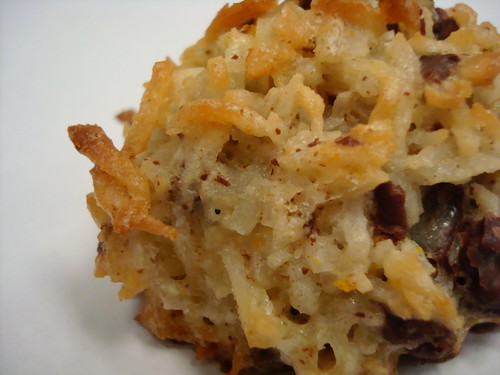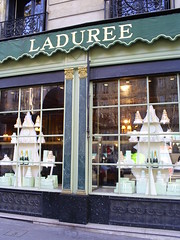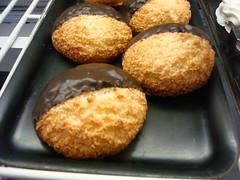
Cakespy Note: Although the terms macaron and macaroon can be used interchangeably for the French version of the cookie, to avoid confusion we have referred to the French version as macaron and the American version as macaroon below. Additionally, thank you to Cake Gumshoe Christine, who made the cookies pictured above.
In magazines, online and in fancy restaurants these days, it's hard not to run into the macaron--you know, that delicate little French sweet-burger of a cookie. And while yes, the macaron does have a certain je ne sais quoi, we at Cakespy can't help but feel for their ugly little sister, the coconut macaroon. It's quite different from its French counterpart--usually a lumpy, coconut-rich confection, often dipped in chocolate. No, they're not pretty, but there's something unpretentious and charming in their unabashed excess: they're extremely sweet, extremely rich, and extremely...coconutty. And so, we'd like to take a few moments to rediscover the coconut macaroon, and why it ought to be loved:

First things first: how in the world are these two cookies related? While they don't look or taste the same, they are indeed part of the same family tree. While there is evidence of meringue-type cookies going as far back as the 1500s, the macaron in its current form is accepted as taking shape in the late 1700s when two Benedictine nuns, Sister Marguerite and Sister Marie-Elisabeth were seeking asylum in the town of Nancy during the French Revolution, and paid for their housing by baking and selling the macaron cookies. However, these original macarons were simply cookie rounds--it wasn't until the 1930s that fancy tea room Ladurée began serving the cookies in a new way, with a sweet ganache filling between two of the traditional rounds. Naturally, the sweet filling and flavor and texture contrast caught on, and the l'il Luxembourgers began to take the world by storm
(read more about the Frenchie ones in this fantastic writeup by one of our favorite foodies, Robyn Lee).

However, veering on a different path than
Ladurée, the cookie also gained popularity with the Italian Jewish population because it requires no flour or leavening (the agent that raises and lightens a baked good, like yeast, baking powder and baking soda—instead, macaroons are leavened by egg whites) and can be enjoyed during Passover. Naturally, due to a high level of deliciousness, it gained popularity all over Europe as a year-round sweet, and regional variations popped up. The coconut macaroon seems to have gained popularity first in Glasgow, Scotland; it is most likely from here that it hopped over the pond and captured the hearts of Americans.
So, that's the story of the macaroon, or at least the best we could piece it together (our sources listed below). But more importantly, why should you love the coconut macaroon? Well, here are several points in its favor:
Transportability: With its lumpy texture and dense shape, this is an easily transportable treat, ideal for packing in a lunch or carrying in a bag for an on-the-go snack. Try doing that with a macaron, we dare you--those babies are so delicate they'll crack if you look at them wrong. So high maintenance!
Shelf Life: The French macaron, with its meringue-y outer shell, is not only delicate, but it goes stale very rapidly; in our opinion, its texture and taste are severely compromised if they are not consumed the same day they are made. On the other hand, coconut macaroon seems to last longer if stored properly; we've had fantastic macaroon experiences even two or three days after baking. Whether it's due to their higher fat content or its denser texture, we don't know, but we like the idea of a cookie that's not gonna love us and leave us the very next day.
Nutrition: Coconut is very high in Manganese, a mineral that is part of many different enzymes working throughout the body. Manganese deficiencies can cause weight loss, nausea and vomiting, poor growth, and abnormal reproduction. Clearly, you don't want any of that! By simply adding some sugar, egg whites and flour to your coconut, you have thus created a pleasurable way to increase your Manganese intake.

Brownies, combining with: Though perhaps you haven't thought much about browniefication (the art of combining brownies with other baked goods), clearly the coconut macaroon is a fine choice when you're considering what cookie addition might give your brownies a little "oomph". As proven by the Macaroon Brownie at Dish D'Lish in Seattle, it is a marriage made in heaven. Try that with a macaron.
Pop Culture: Coconut macaroons have made several appearances in film and TV:
- They play a major role in the 1994 black comedy "Freaked" when one of the main characters complains of the coconut being "skimped on" in his macaroon. So sad!
- In the first Season of The Sopranos, Tony tries to play peacemaker by presenting his mother with a box of macaroons, which he knows to be her favorite. Though it's clear that Livia Soprano wants those cookies, she's one manipulative mom and ultimately turns them away. Quel dommage!
 Where can you buy coconut macaroons? Online, here are a few spots: coconutmountain.com will ship coconut macaroons anywhere in the US from New Hampshire; Tripician's, who have been making macaroons since 1910, will ship them anywhere in the US from Southern NJ; The Macaroon Shop in Avon-By-The-Sea, NJ, will also ship within the US; online ordering is not available, but their contact information can be found at macaroonshop.com.
Where can you buy coconut macaroons? Online, here are a few spots: coconutmountain.com will ship coconut macaroons anywhere in the US from New Hampshire; Tripician's, who have been making macaroons since 1910, will ship them anywhere in the US from Southern NJ; The Macaroon Shop in Avon-By-The-Sea, NJ, will also ship within the US; online ordering is not available, but their contact information can be found at macaroonshop.com.
How can you make coconut macaroons? Well, you could use the
recipe listed in this previous post from the Sweet Melissa Cookbook, which we've tried and is fantastic (photo top); or, you could give this exceedingly rich and delicious one a try (we love the sweetened condensed milk--so bad, but
so good), from the Barefoot Contessa:
Coconut Macaroons
- 14 ounces sweetened shredded coconut
- 14 ounces sweetened condensed milk
- 1 teaspoon pure vanilla extract
- 2 extra-large egg whites, at room temperature
- 1/4 teaspoon kosher salt
Directions:
- Preheat the oven to 325 degrees F.
- Combine the coconut, condensed milk, and vanilla in a large bowl. Whip the egg whites and salt on high speed in the bowl of an electric mixer fitted with the whisk attachment until they make medium-firm peaks. Carefully fold the egg whites into the coconut mixture.
- Drop the batter onto sheet pans lined with parchment paper using either a 1 3/4-inch diameter ice cream scoop, or two teaspoons. Bake for 25 to 30 minutes, until golden brown. Cool and serve.



 Where can you buy coconut macaroons? Online, here are a few spots: coconutmountain.com will ship coconut macaroons anywhere in the US from New Hampshire; Tripician's, who have been making macaroons since 1910, will ship them anywhere in the US from Southern NJ; The Macaroon Shop in Avon-By-The-Sea, NJ, will also ship within the US; online ordering is not available, but their contact information can be found at macaroonshop.com.
Where can you buy coconut macaroons? Online, here are a few spots: coconutmountain.com will ship coconut macaroons anywhere in the US from New Hampshire; Tripician's, who have been making macaroons since 1910, will ship them anywhere in the US from Southern NJ; The Macaroon Shop in Avon-By-The-Sea, NJ, will also ship within the US; online ordering is not available, but their contact information can be found at macaroonshop.com.

